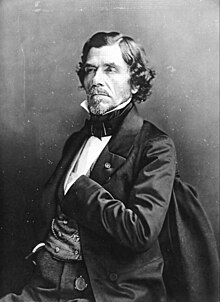Eugène Delacroix

Eugène Delacroix | |
|---|---|
 Eugène Delacroix (portrait by Nadar) | |
| Born | Ferdinand Victor Eugène Delacroix 26 April 1798 |
| Died | 13 August 1863 (aged 65) |
| Nationality | French |
| Known for | Painting, Lithography |
| Notable work | Liberty Leading the People, 1830 |
| Movement | Romanticism |
Ferdinand Victor Eugène Delacroix (26 April 1798 – 13 August 1863) was a French Romantic artist regarded from the outset of his career as the leader of the French Romantic school.[1] Delacroix's use of expressive brushstrokes and his study of the optical effects of colour profoundly shaped the work of the Impressionists, while his passion for the exotic inspired the artists of the Symbolist movement. A fine lithographer, Delacroix illustrated various works of William Shakespeare, the Scottish writer Sir Walter Scott, and the German writer Johann Wolfgang von Goethe.
In contrast to the Neoclassical perfectionism of his chief rival Ingres, Delacroix took for his inspiration the art of Rubens and painters of the Venetian Renaissance, with an attendant emphasis on color and movement rather than clarity of outline and carefully modeled form. Dramatic and romantic content characterized the central themes of his maturity, and led him not to the classical models of Greek and Roman art, but to travel in North Africa, in search of the exotic.[2] Friend and spiritual heir to Théodore Géricault, Delacroix was also inspired by Byron, with whom he shared a strong identification with the "forces of the sublime", of nature in often violent action.[3]
However, Delacroix was given neither to sentimentality nor bombast, and his Romanticism was that of an individualist. In the words of Baudelaire, "Delacroix was passionately in love with passion, but coldly determined to express passion as clearly as possible."[4]
Delacroix was a member of the Club des Hashischins, or Hashish Club. This group of French writers experimented with hashish to get ideas.[5]
References
[change | change source]- ↑ Noon, Patrick, et al., Crossing the Channel: British and French Painting in the Age of Romanticism, p. 58, Tate Publishing, 2003. ISBN 1-85437-513-X
- ↑ Gombrich, E.H., The Story of Art, page 504-6. Phaidon Press Limited, 1995. ISBN 0-7148-3355-X
- ↑ Clark, Kenneth, Civilisation, page 313. Harper and Row, 1969.
- ↑ Wellington, Hubert, The Journal of Eugène Delacroix, introduction, page xiv. Cornell University Press, 1980. ISBN 0-8014-9196-7
- ↑ "Drug Use from Encyclopedia of Medical Anthropology: Health and Illness in the World's Cultures". credoreference.com. 2011. Retrieved 15 May 2011.